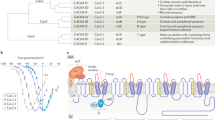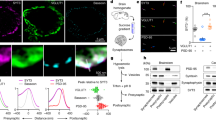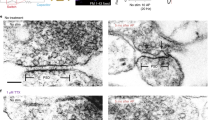Abstract
How synaptic-vesicle release is controlled at the basic release structure, the active zone, is poorly understood. By performing cell-attached current and capacitance recordings predominantly at single active zones in rat calyces, we found that single active zones contained 5−218 (mean, 42) calcium channels and 1−10 (mean, 5) readily releasable vesicles (RRVs) and released 0−5 vesicles during a 2-ms depolarization. Large variation in the number of calcium channels caused wide variation in release strength (measured during a 2-ms depolarization) by regulating the RRV release probability (PRRV) and the RRV number. Consequently, an action potential opened ∼1–35 (mean, ∼7) channels, resulting in different release probabilities at different active zones. As the number of calcium-channels determined PRRV, it critically influenced whether subsequent release would be facilitated or depressed. Regulating calcium channel density at active zones may thus be a major mechanism to yield synapses with different release properties and plasticity. These findings may explain large differences reported at synapses regarding release strength (release of 0, 1 or multiple vesicles), PRRV, short-term plasticity, calcium transients and the requisite calcium-channel number for triggering release.
This is a preview of subscription content, access via your institution
Access options
Subscribe to this journal
Receive 12 print issues and online access
$209.00 per year
only $17.42 per issue
Buy this article
- Purchase on Springer Link
- Instant access to full article PDF
Prices may be subject to local taxes which are calculated during checkout







Similar content being viewed by others
References
Murthy, V.N., Sejnowski, T.J. & Stevens, C.F. Heterogeneous release properties of visualized individual hippocampal synapses. Neuron 18, 599–612 (1997).
Dobrunz, L.E. & Stevens, C.F. Heterogeneity of release probability, facilitation, and depletion at central synapses. Neuron 18, 995–1008 (1997).
Xu-Friedman, M.A., Harris, K.M. & Regehr, W.G. Three-dimensional comparison of ultrastructural characteristics at depressing and facilitating synapses onto cerebellar Purkinje cells. J. Neurosci. 21, 6666–6672 (2001).
Wadiche, J.I. & Jahr, C.E. Multivesicular release at climbing fiber-Purkinje cell synapses. Neuron 32, 301–313 (2001).
Zucker, R.S. & Regehr, W.G. Short-term synaptic plasticity. Annu. Rev. Physiol. 64, 355–405 (2002).
Abbott, L.F. & Regehr, W.G. Synaptic computation. Nature 431, 796–803 (2004).
Schikorski, T. & Stevens, C.F. Quantitative ultrastructural analysis of hippocampal excitatory synapses. J. Neurorsci. 17, 5858–5867 (1997).
Schikorski, T. & Stevens, C.F. Morphological correlates of functionally defined synaptic vesicle populations. Nat. Neurosci. 4, 391–395 (2001).
Reyes, A. et al. Target-cell-specific facilitation and depression in neocortical circuits. Nat. Neurosci. 1, 279–285 (1998).
Koester, H.J. & Johnston, D. Target cell-dependent normalization of transmitter release at neocortical synapses. Science 308, 863–866 (2005).
Brenowitz, S.D. & Regehr, W.G. Reliability and heterogeneity of calcium signaling at single presynaptic boutons of cerebellar granule cells. J. Neurosci. 27, 7888–7898 (2007).
Adler, E.M., Augustine, G.J., Duffy, S.N. & Charlton, M.P. Alien intracellular calcium chelators attenuate neurotransmitter release at the squid giant synapse. J. Neurosci. 11, 1496–1507 (1991).
Stanley, E.F. Single calcium channels and acetylcholine release at a presynaptic nerve terminal. Neuron 11, 1007–1011 (1993).
Borst, J.G.G. & Sakmann, B. Calcium influx and transmitter release in a fast CNS synapse. Nature 383, 431–434 (1996).
Wu, L.G., Westenbroek, R.E., Borst, J.G.G., Catterall, W.A. & Sakmann, B. Calcium channel types with distinct presynaptic localization couple differentially to transmitter release in single calyx-type synapses. J. Neurorsci. 19, 726–736 (1999).
Wu, L.G. & Borst, J.G.G. The reduced release probability of releasable vesicles during recovery from short-term synaptic depression. Neuron 23, 821–832 (1999).
Sudhof, T.C. The synaptic vesicle cycle. Annu. Rev. Neurosci. 27, 509–547 (2004).
Moulder, K.L. & Mennerick, S. Reluctant vesicles contribute to the total readily releasable pool in glutamatergic hippocampal neurons. J. Neurosci. 25, 3842–3850 (2005).
Wadel, K., Neher, E. & Sakaba, T. The Coupling between Synaptic Vesicles and Ca(2+) Channels Determines Fast Neurotransmitter Release. Neuron 53, 563–575 (2007).
Shahrezaei, V., Cao, A. & Delaney, K.R. Ca2+ from one or two channels controls fusion of a single vesicle at the frog neuromuscular junction. J. Neurosci. 26, 13240–13249 (2006).
Bucurenciu, I., Bischofberger, J. & Jonas, P. A small number of open Ca2+ channels trigger transmitter release at a central GABAergic synapse. Nat. Neurosci. 13, 19–21 (2010).
Kaeser, P.S. et al. RIM proteins tether Ca2+ channels to presynaptic active zones via a direct PDZ-domain interaction. Cell 144, 282–295 (2011).
Han, Y., Kaeser, P.S., Sudhof, T.C. & Schneggenburger, R. RIM determines Ca(2)+ channel density and vesicle docking at the presynaptic active zone. Neuron 69, 304–316 (2011).
He, L., Wu, X.S., Mohan, R. & Wu, L.G. Two modes of fusion pore opening revealed by cell-attached recordings at a synapse. Nature 444, 102–105 (2006).
Sakmann, B. & Neher, E. Geometric parameters of pipettes and membrane patches. in Single-channel Recording (eds., Sakmann, B. & Neher, E.) 637–650 (Plenum Press, 1995).
Gentet, L.J., Stuart, G.J. & Clements, J.D. Direct measurement of specific membrane capacitance in neurons. Biophys. J. 79, 314–320 (2000).
Sätzler, K. et al. Three-dimensional reconstruction of a calyx of Held and its postsynaptic principal neuron in the medial nucleus of the trapezoid body. J. Neurosci. 22, 10567–10579 (2002).
Dondzillo, A. et al. Targeted three-dimensional immunohistochemistry reveals localization of presynaptic proteins Bassoon and Piccolo in the rat calyx of Held before and after the onset of hearing. J. Comp. Neurol. 518, 1008–1029 (2010).
Xu, J. & Wu, L.G. The decrease in the presynaptic calcium current is a major cause of short-term depression at a calyx-type synapse. Neuron 46, 633–645 (2005).
He, L. et al. Compound vesicle fusion increases quantal size and potentiates synaptic transmission. Nature 459, 93–97 (2009).
Sun, J.Y., Wu, X.S. & Wu, L.G. Single and multiple vesicle fusion induce different rates of endocytosis at a central synapse. Nature 417, 555–559 (2002).
Wu, X.S. et al. The origin of quantal size variation: vesicular glutamate concentration plays a significant role. J. Neurosci. 27, 3046–3056 (2007).
Fedchyshyn, M.J. & Wang, L.Y. Developmental transformation of the release modality at the calyx of held synapse. J. Neurosci. 25, 4131–4140 (2005).
Wolfel, M., Lou, X. & Schneggenburger, R. A mechanism intrinsic to the vesicle fusion machinery determines fast and slow transmitter release at a large CNS synapse. J. Neurosci. 27, 3198–3210 (2007).
Wu, X.S., Sun, J.Y., Evers, A.S., Crowder, M. & Wu, L.G. Isoflurane inhibits transmitter release and the presynaptic action potential. Anesthesiology 100, 663–670 (2004).
Wu, X.S. & Wu, L.G. Rapid endocytosis does not recycle vesicles within the readily releasable pool. J. Neurosci. 29, 11038–11042 (2009).
Taschenberger, H., Leao, R.M., Rowland, K.C., Spirou, G.A. & Von Gersdorff, H. Optimizing synaptic architecture and efficiency for high-frequency transmission. Neuron 36, 1127–1143 (2002).
Sun, J.Y. & Wu, L.G. Fast kinetics of exocytosis revealed by simultaneous measurements of presynaptic capacitance and postsynatpic currents at a central synapse. Neuron 30, 171–182 (2001).
Sakaba, T. & Neher, E. Calmodulin mediates rapid recruitment of fast-releasing synaptic vesicles at a calyx-type synapse. Neuron 32, 1119–1131 (2001).
Borst, J.G.G., Helmchen, F. & Sakmann, B. Pre- and postsynaptic whole-cell recordings in the medial nucleus of the trapezoid body of the rat. J. Physiol. (Lond.) 489, 825–840 (1995).
Helmchen, F., Borst, J.G.G. & Sakmann, B. Calcium dynamics associated with a single action potential in a CNS presynaptic terminal. Biophys. J. 72, 1458–1471 (1997).
Schneggenburger, R., Meyer, A.C. & Neher, E. Released fraction and total size of a pool of immediately available transmitter quanta at a calyx synapse. Neuron 23, 399–409 (1999).
Borst, J.G.G. & Sakmann, B. Calcium current during a single action potential in a large presynaptic terminal of the rat brainstem. J. Physiol. (Lond.) 506, 143–157 (1998).
Neher, E. & Sakaba, T. Combining deconvolution and noise analysis for the estimation of transmitter release rates at the calyx of held. J. Neurosci. 21, 444–461 (2001).
Wölfel, M. & Schneggenburger, R. Presynaptic capacitance measurements and Ca2+ uncaging reveal submillisecond exocytosis kinetics and characterize the Ca2+ sensitivity of vesicle pool depletion at a fast CNS synapse. J. Neurosci. 23, 7059–7068 (2003).
Stanley, E.F. & Mirotznik, R.R. Cleavage of syntaxin prevents G-protein regulation of presynaptic calcium channels. Nature 385, 340–343 (1997).
Suh, B.C., Leal, K. & Hille, B. Modulation of high-voltage activated Ca(2+) channels by membrane phosphatidylinositol 4,5-bisphosphate. Neuron 67, 224–238 (2010).
Dolphin, A.C. Calcium channel diversity: multiple roles of calcium channel subunits. Curr. Opin. Neurobiol. 19, 237–244 (2009).
Luo, F., Dittrich, M., Stiles, J.R. & Meriney, S.D. Single-pixel optical fluctuation analysis of calcium channel function in active zones of motor nerve terminals. J. Neurosci. 31, 11268–11281 (2011).
Weber, A.M. et al. N-type Ca2+ channels carry the largest current: implications for nanodomains and transmitter release. Nat. Neurosci. 13, 1348–1350 (2010).
Nowycky, M.C., Fox, A.P. & Tsien, R.W. Three types of neuronal calcium channel with different calcium agonist sensitivity. Nature 316, 440–443 (1985).
Usowicz, M.M., Sugimori, M., Cherksey, B. & Llinás, R.R. P-type calcium channels in the somata and dendrites of adult cerebellar purkinje cells. Neuron 9, 1185–1199 (1992).
Meinrenken, C.J., Borst, J.G. & Sakmann, B. Calcium secretion coupling at calyx of held governed by nonuniform channel-vesicle topography. J. Neurosci. 22, 1648–1667 (2002).
Acknowledgements
We thank K. Sätzler and J. Lübke for providing the electron microscopy data for analysis, and J. Diamond, J. Xu and M. Baydyuk for comments on the manuscript. This work was supported by the US National Institute of Neurological Disorders and Stroke Intramural Research Program.
Author information
Authors and Affiliations
Contributions
J.S. performed most experiments, designed experiments and participated in writing the paper. L.H. designed experiments and developed the method of patching single active zones. L.X. recorded whole-cell calcium currents in the presence of the P/Q-type channel blocker. F.L. participated in designing experiments. H.Z. and T.K. performed computational analysis of the active-zone density. D.T.Y. ensured low-noise single-channel recordings and contributed to experimental design. W.S. and T.S. assisted the project. L.-G.W. designed experiments, supervised the project and wrote the paper.
Corresponding author
Ethics declarations
Competing interests
The authors declare no competing financial interests.
Supplementary information
Supplementary Text and Figures
Supplementary Figures 1–9 and Supplementary Table 1 (PDF 254 kb)
Rights and permissions
About this article
Cite this article
Sheng, J., He, L., Zheng, H. et al. Calcium-channel number critically influences synaptic strength and plasticity at the active zone. Nat Neurosci 15, 998–1006 (2012). https://doi.org/10.1038/nn.3129
Received:
Accepted:
Published:
Issue Date:
DOI: https://doi.org/10.1038/nn.3129
This article is cited by
-
Membrane transformations of fusion and budding
Nature Communications (2024)
-
Three Modalities of Synaptic Neurotransmitter Release: Rapid Synchronized, Multivesicular, and Asynchronous. Similarities and Differences in Mechanisms
Neuroscience and Behavioral Physiology (2020)
-
Underpinning heterogeneity in synaptic transmission by presynaptic ensembles of distinct morphological modules
Nature Communications (2019)
-
Quantitative optical nanophysiology of Ca2+ signaling at inner hair cell active zones
Nature Communications (2018)
-
Postsynaptic, not presynaptic NMDA receptors are required for spike-timing-dependent LTD induction
Nature Neuroscience (2016)



